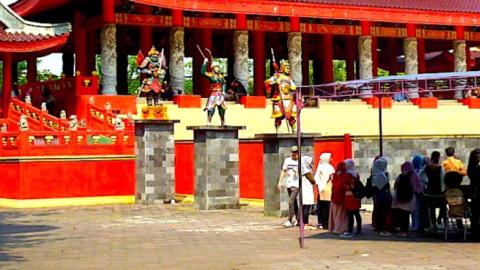SEMARANG, Indonesia — The people of Semarang, the largest city of Central Java, Indonesia, are mostly ethnic Javanese, but there is a colorful and captivating mix of peoples and religions. Its oldest Chinese temple complex is Sam Poo Kong, also known as Gedung Batu. Around its wide central courtyard there are pavilions of deep red and shining gold, with dramatic dragons and intricately curved roofs reminiscent of the Forbidden City in Beijing.
Pak Chandra, the head of the Temple foundation, escorted us through the complex and told how it is used regularly by Buddhists, Daoists and Confucians. He then pointed to something hard to miss, a 35-foot tall bronze statue honoring a man who was neither Buddhist, nor Daoist, nor Confucian, but Muslim.
Nearby was an ornate temple with sweet burning incense, which marked the tomb of yet another Muslim.
Meanwhile, behind us on a temporary stage, German students were performing leg-slapping Bavarian dances and trying to teach German songs to a noisy, laughing audience of several hundred people, which seemed to consist mostly of hijab-clad Muslim women. Here we are in Indonesia, the world’s largest Muslim country.
A Chinese Muslim admiral
The statue that Pak Chandra highlighted is of the famous Chinese admiral who Indonesians usually call Laksamana Cheng Ho, and who Westerners typically refer to as Zheng He. In Indonesia, he is also known as Sam Poo Tay Djien, and it is for him that the whole temple complex is named. According to tradition, in the early fifteenth century, on the instructions of the Ming Emperor, the admiral made seven major voyages and visited much of Asia and Africa. On these travels, he visited Semarang and prayed in a cave there.
Reputedly, he returned in 1416 when his helmsman, Wang Jin Hong, had fallen very ill. Cheng Ho dropped him off in Semarang to receive medical treatment, and the helmsman recovered. But rather than trying to return to the fleet, he stayed in the town, mingled with the locals, and lived to the ripe old age of 87. He built a statue of Cheng Ho in the area, and his own tomb is now also a temple on the grounds of Sam Poo Kong. In the whole complex, there are four temples, named for the Goddess of the Sea, the God of the Earth, helmsman Wang Jin Hong, and Cheng Ho himself.
In China itself, subsequent emperors erased the records of Cheng Ho’s life and he was virtually forgotten until recent times, but his statue graces this temple because he has great religious and political significance in Indonesia. He combines traditions because he was both Chinese and Muslim and is widely venerated as an early Islamic apostle to the country. This makes him a symbol in efforts to strengthen religious and racial harmony in the country.
China and Indonesian Islam
The historical evidence of how Islam arrived and grew in Indonesia is fragmentary. Some influence probably came directly from Arabia in the ninth century, or earlier, but its effects appear to have been merely local. Later, there were Sufi merchants, many from India, who traded throughout the area and whose influence led to conversions, especially among coastal elites. Hinduism, Buddhism, and local religions remained strong in the islands.
One fascinating link may have come from China. Cheng Ho, along with a number of his officers, was from the Hui people, Chinese Muslims. They are regarded by many as establishing and aiding Muslim communities in Asia and Africa, including Sumatra, the Philippines, Malaysia, and also here in Java. The famous Indonesian writer, Hamka, wrote that the “development of Islam in Indonesia and Malaysia is intimately related to a Chinese Muslim, Admiral Zheng He.”
This combination of Chinese influence and Islam is important because of the still widespread animosity to ethnic Chinese in the country. Indonesian Chinese have long been overrepresented in the economic elites, which has led to resentment from other groups. The 1965 attempted coup, which resulted in hundreds of thousands of deaths, has long been blamed on the still-banned Indonesian Communist Party, historically supported by China, and this further strengthened anti-Chinese sentiment. Many Chinese converted to Islam in order to better blend in. Later, in the turmoil surrounding the deposition of long-time dictator Suharto in 1998, there were further anti-Chinese riots.
In the face of this history, Cheng Ho’s life and statue can bolster a uniting belief that China was not simply a distant imperial power but was one conduit of Indonesian Islam. Hence being Chinese and Muslim means being thoroughly Indonesian. Consequently, Muslims and Christians, as well as Buddhists, Confucians, and Taoists, can gather here, or else simply come as tourists. One may see a Muslim man, or a woman in a hijab, praying near an altar in the compound, burning incense sticks and placing them in a censer.
Tourists and Bavarian dances
The Bavarian folk singers and dancers, along with Russians, Swiss, Indians, Malaysians, and others, from over forty countries, fit this pattern. They were there under the auspices of AIESEC, a Canadian-based NGO that brings youth from around the world to meet one another and develop leadership skills. Apparently, part of their leadership skill-building was to publicly perform songs and dances from their own country. The Muslim women happily singing Bavarian songs were students from the local Diponegoro University, which had rented the temple complex for the celebration.
Even when there are no special events, the temple is a frequent destination for school trips, including from local Muslim schools. Pupils and other visitors often rent richly embroidered Chinese robes and take a multitude of selfies complete with ornate Chinese hats perched upon hijab-covered heads. Here too China and Islam come together.
It would perhaps be too much to say that watching Bavarian dancers performing before mostly Muslim women in a Taoist temple overlooked by a giant statue of a Chinese admiral is an everyday occurrence in Indonesia. Such events are certainly not routine. But they happen and reveal something about the dominant forms of Islam that still predominate in the world’s largest Muslim-majority country.
Another local hero
In the nearby Tay Kak Sie Buddhist temple is another small example. This temple holds classes in Chinese art and culture and runs a free school open to disadvantaged children of any religion or ethnicity. It also has a sacred area in which to place Sin Chi, which are boards containing the names of important people, usually Buddhist, who have died. One of these boards commemorates a Muslim, an old acquaintance of mine, Abdurrahman Wahid, the widely respected former President of Indonesia and head of the world’s largest Muslim organization Nahdlatul Ulama. The Sin Chi honors him as a father of pluralism in Indonesia, and that he also made Chinese New Year an Indonesian national holiday.
Read in Religion Unplugged



















